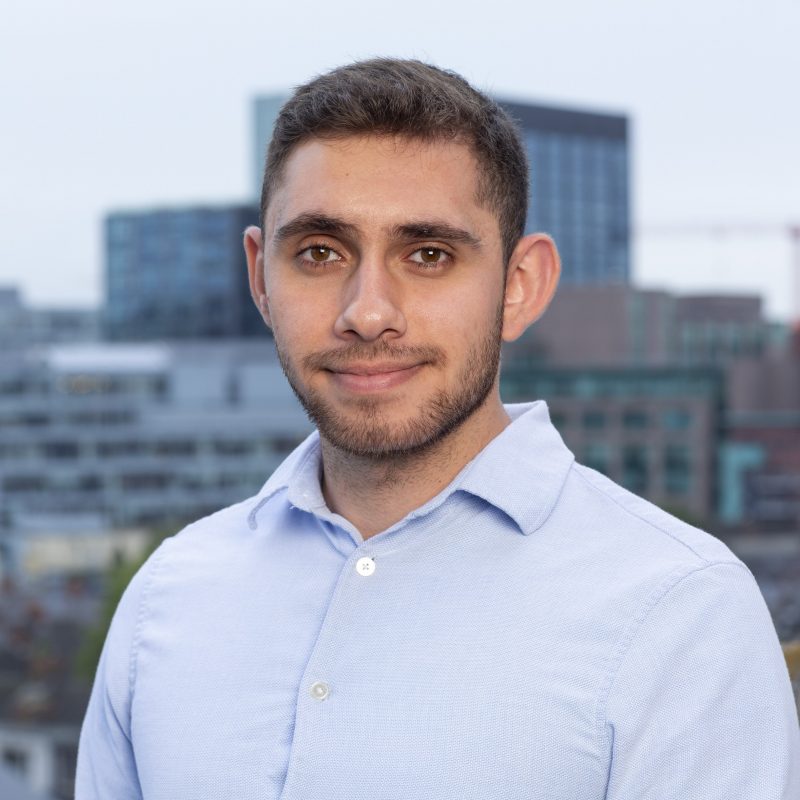
Why did you choose to study building engineering at Politecnico di Milano after your bachelor’s degree?
After finishing my bachelor’s degree in architecture back home, at the Académie Libanaise des Beaux-Arts, I was satisfied with the skills and knowledge acquired in the architectural field and decided to explore new disciplines to upskill myself. I was interested in understanding how my architectural decisions would impact the different systems that come at play when designing a building. I believed that a comprehensive understanding of those systems would help in the decision making and optimisation process of the build, not only from a spatial and architectural perspective, but also from an engineering one.
The curriculum that Politecnico di Milano offered aligned with my desired career growth, it walked students through the different engineering disciplines that help design a building. The program allowed students to understand the wider picture of how buildings work by diving into the detailed design of each of its components: structural elements, façade components, mechanical systems, and energy models.
On top of that, the master’s program was ranked top 10 in the world in the architecture, engineering and construction field and was renowned for having Renzo Piano (a personal favourite) as alumni which helped seal the deal.
What are the main difficulties you dealt with while studying and living in Italy? How did you manage them?
Starting from scratch in a foreign country can get overwhelming, one of the main difficulties is the numerous new variables that come into your life all at once: learning a new language, making new friends, adapting to a new culture and lifestyle, dealing with extensive paperwork and appointments, all while keeping on top of your studies. Although it is daunting to tackle everything simultaneously, the best way to overcome these challenges is through thorough preparation and early exposure to the new environment. The earlier you subject yourself to it, the faster you adapt and become comfortable in it.
Another difficulty was obviously the career change from architecture to building engineering. A lot of the courses start slowly to accommodate students from different backgrounds (Architecture, Civil, Mechanical, etc.) but push to an advanced level few weeks in to maintain the high standards of the program. Hence, the first semester was critical to catch-up with the course materials and other students, building strong foundations for the subsequent, equally challenging semesters.
It is important to work hard, and to find like-minded friends who are equally dedicated. You are not alone in this journey and all the challenges become much easier with collective effort.
What are the main differences between studying in your home country and studying at Politecnico di Milano?
One of the main differences when studying at Politecnico di Milano is the diverse background of the students in the curriculum. This led to the creation of a collaborative learning environment where each person was able to learn from another person’s advanced knowledge in their own discipline of origin.
Moreover, a lot of the courses were focused on group projects, this meant you would have most of the times on the same call a structural engineer, a mechanical engineer, and an architect trying to navigate through different engineering and design exercises together. The inputs from the different individuals led to well-thought projects that took multiple engineering and design constraints into consideration before delivering the final product.
Finally, the program structure provided flexibility to students regarding how they approach exam season. You were allowed to reject grades given by your professor if you were not satisfied with your performance and retake the exam in future dates without delaying your course of studies. It overall reduced stress during the exam period and allowed students to perform better in their exams from their second time (or even third) if they didn’t do well from the first time.
What are the opportunities that this Master Program offered to your personal and professional growth? How were they useful to your career development?
Towards the end of the program, I was faced with many possible directions to my career, the program had provided me the necessary skills and knowledge to become an engineer, designer, or consultant in multiple possible fields: structural engineering, façade engineering, mechanical engineering, building energy performance consultancy, or computational design.
During my course of studies, I found myself performing great in computational design courses, especially the “Adaptive Façade Studio” course taught by Pierpaolo Ruttico. The great work done by my colleagues, and I back then led to our project being showcased in the Milan Design Week. This experience allowed us to use the Index Lab at Politecnico di Milano to further develop our project, 3D print it, design an augmented reality environment, and then showcase the final product in a weeklong exhibition. I had also developed in that time a keen interest for energy modelling of buildings where I could understand the direct impact that any architectural decision would have on the indoor comfort and energy performance of the building. I was interested in merging the best of both in my new career direction and after a rigorous search, I was able to find a great team in Arup’s Dublin office that wanted to further expand their computational design services in the sustainability team.
Fortunately, the curriculum had taught me in-demand skills and tools that were transferable from theoretical exercises to real life projects which helped to hit the ground running on projects in Arup and made the transition to the team much easier and smoother! Working in Arup today and meeting colleagues that did the same program as I did, while each occupying different engineering roles in the company, proves just how successful this program was and probably the best decision in my career so far.